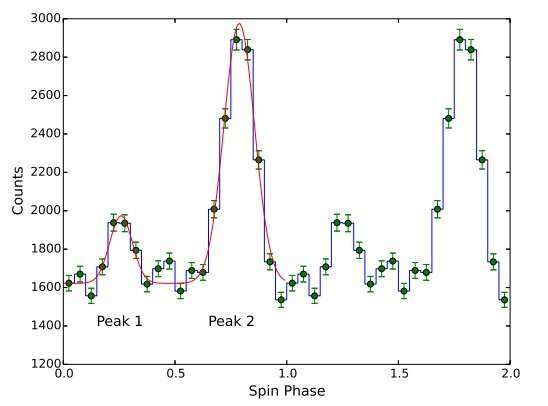Pulse profile of PSR J2021+4026 in MJD 58,244-58,722 (LGF/HSD state after 2018 state change). Credit: Takata et al., 2020.
Using NASA's Fermi telescope, astronomers have detected a state change of the gamma-ray emission and spin-down rate of the variable radio-quiet gamma-ray pulsar PSR J2021+4026. Such behavior was first observed in this pulsar in 2011, and the new detection could shed light on the mechanism of state switching in gamma-ray pulsars. The finding is detailed in a paper published January 2 on arXiv.org.
Gamma-ray pulsars are rotating neutron stars emitting gamma-ray photons. Some of them are completely radio-quiet, which means that observations in other regimes are needed to learn about their properties.
PSR J2021+4026 (or 3FGL J2021.5+4026) is one of the brightest radio-quiet gamma-ray pulsars. In October 2011, observations of this object with Fermi revealed a sudden gamma-ray flux drop and a change of the observed flux over a timescale of less than a week, which made it the first known variable gamma-ray pulsar. The researchers also found that the spin-down rate of this pulsar has changed. All in all, the object switched from high gamma-ray flux (HGF) and low spin-down (LSD) rate state to low gamma-ray flux (LGF) and high spin-down (HSD) rate state.
Subsequent observations of PSR J2021+4026 have shown that around December 2014, it returned to the HGF/LSD state over a timescale of a few months. Now, a team of astronomers led by Jumpei Takata of Huazhong University of Science and Technology in Wuhan, China, reports that the pulsar appears to have experienced one more state change. This assumption is based on the results of timing and spectral study of the source with Fermi.
"The timing and spectral analysis suggest that PSR J2021+4026 entered new LGF/HSD state at around 2018 February 1st," the astronomers wrote in the paper.
According to the study, the long-term evolution of the gamma-ray flux and timing behavior of PSR J2021+4026 are indicative of a new state change near the first day of February 2018. This state change occurred over a timescale of less than 10 days and its properties were similar to that of 2011, however, with a spin-down rate in the new state slightly smaller than that measured after the event that took place almost a decade ago.
The researchers noted that the state switching of PSR J2021+4026 is likely caused by change of the magnetic field structure of the polar cap region. The astronomers added that it is possible that the crust cracking or other processes change the magnetic field structure or field strength in the polar cap region, and this process affects the created current and hence the pulsar's spin-down rate.
The study suggests that the state change in PSR J2021+4026 occurs every several years. However, the exact time interval is still unknown and further monitoring of this pulsar is needed to get more precise data.
Summing up the results, the astronomers emphasized that although state-switching pulsars have been discovered in the radio bands, PSR J2021+4026 is the first switching pulsar discovered in gamma-rays. Therefore, this source provides a unique opportunity to further study the mechanisms state switching in gamma-ray pulsars.
More information: Repeated state change of variable gamma-ray pulsar, PSR J2021+4026, arXiv:2001.00289 [astro-ph.HE] arxiv.org/abs/2001.00289
© 2020 Science X Network
























